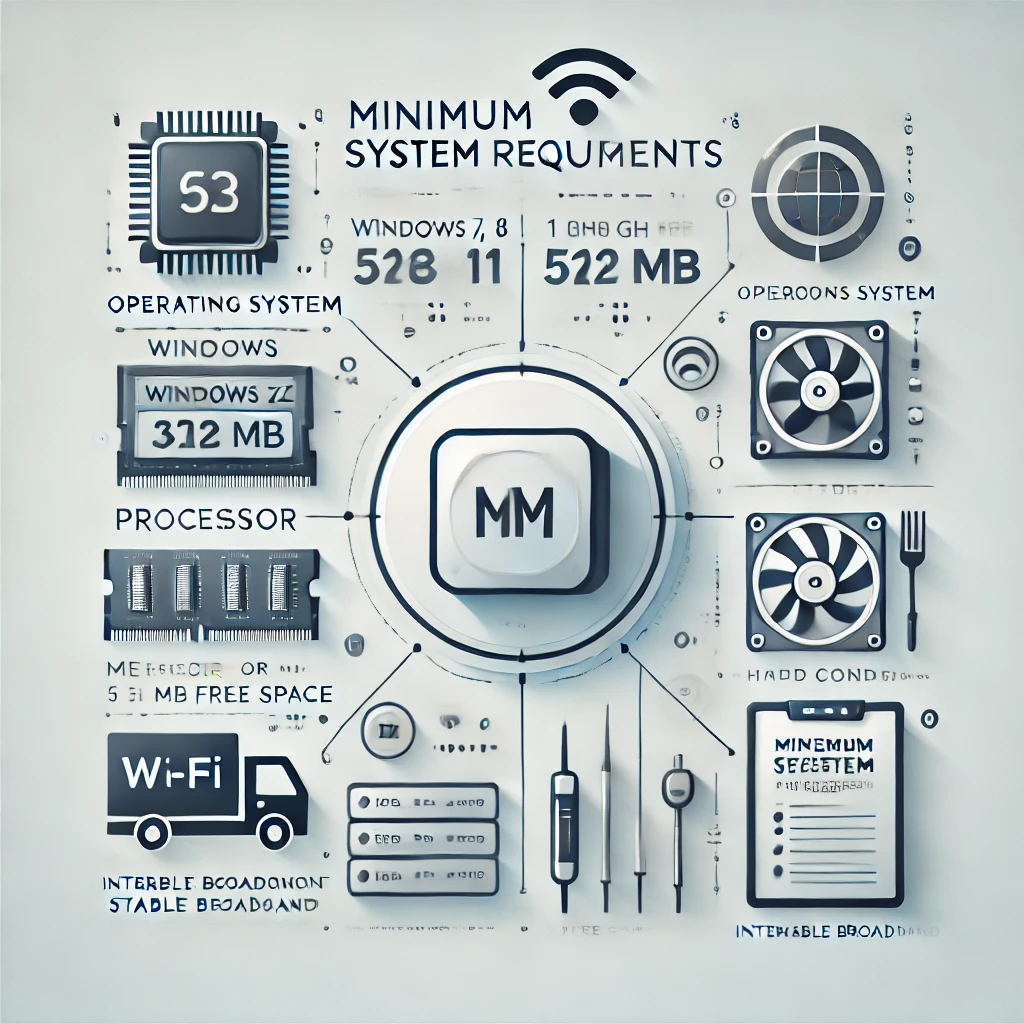Radmin VPN is a powerful, free-to-use virtual private network tool designed to create secure and reliable connections between remote devices. Whether you want to connect with friends, colleagues, or team members across different locations, Radmin VPN allows you to establish a safe network that feels like you’re in the same physical space. However, to get the most out of this software, it’s essential to ensure your system meets the appropriate specifications.
Knowing the system requirements for Radmin VPN helps you avoid compatibility issues, performance lags, or connection failures. These requirements vary depending on the operating system, hardware, and software configurations of your device. In this article, we’ll cover the minimum and recommended system requirements for Radmin VPN, as well as provide additional information on network and security settings. Understanding these details will ensure that you have a smooth and hassle-free experience while using Radmin VPN for your remote networking needs.
Minimum System Requirements
To ensure that Radmin VPN functions correctly on your device, it’s essential to meet the minimum system requirements. These are the basic specifications needed to run the software with minimal performance and functionality.

- Operating System: Radmin VPN is primarily designed for Windows, with support for versions from Windows 7 up to Windows 11. While Linux users can also use Radmin VPN with a compatible setup, Windows is the recommended platform.
- Processor (CPU): The software requires at least a 1 GHz processor, which is typically found in most modern computers. This is sufficient for basic VPN functionality, though higher speeds will improve overall performance.
- Memory (RAM): At least 2 GB of RAM is needed to run Radmin VPN. While this is the minimum, having more memory will enhance performance, especially when using multiple remote connections simultaneously.
- Hard Drive Space: The software requires around 50 MB of available hard drive space for installation. This ensures the smooth operation of the software without taking up significant system resources.
- Network: A stable internet connection is essential. While Radmin VPN does not require an extremely high-speed connection, a minimum speed of 1 Mbps is recommended for effective usage.
These minimum system requirements will allow you to install and run Radmin VPN, though upgrading your hardware or network speed can provide a better experience.
Recommended System Requirements
The Recommended System Requirements for Radmin VPN refer to the ideal hardware and software specifications that will ensure the software runs smoothly, providing the best possible user experience. These requirements are generally higher than the minimum system requirements, allowing the VPN software to function more efficiently and with fewer performance issues, especially in demanding environments.
Here’s a breakdown of the Recommended System Requirements for Radmin VPN:
1. Operating System
- Recommended OS: Windows 10, 11 (64-bit), or the latest stable versions of other supported operating systems like Linux.
- These versions provide the latest security patches, performance optimizations, and compatibility with Radmin VPN’s features.
2. Processor (CPU)
- Recommended CPU: Dual-core processor (2 GHz or higher)
- A more powerful CPU improves the ability to handle multiple tasks simultaneously, making Radmin VPN more responsive and able to manage higher network traffic more efficiently.
3. Memory (RAM)
- Recommended RAM: 4 GB or more
- Having at least 4 GB of RAM ensures the system can handle VPN encryption, data transfer, and other background processes without slowing down. More RAM can be helpful if running multiple applications or having multiple users connected to the VPN at once.
4. Hard Drive Space
- Recommended Disk Space: At least 50-100 MB of free disk space
- Radmin VPN doesn’t take up a lot of space, but having ample free space is essential for smooth performance, especially if you plan to use the software extensively or have several data transfers happening over the VPN.
5. Network Connection
- Recommended Network Speed: 10 Mbps or higher (both upload and download)
- A faster and stable internet connection will ensure better VPN performance, reducing latency and improving the speed of file sharing or remote access via Radmin VPN.
6. Additional Software
- Software Requirements: Ensure that you have the latest updates of Radmin VPN and any supporting software like the .NET Framework (if applicable) installed on your system for full functionality.
- Updating system drivers and ensuring firewall rules are correctly configured can also help improve the experience.
By meeting or exceeding these recommended requirements, users can ensure that Radmin VPN operates without issues like lag, dropped connections, or excessive CPU/RAM usage. These specs are especially important in professional environments or when using Radmin VPN for larger networks with multiple users or devices.
Additional Software and Hardware Requirements
When setting up Radmin VPN, certain software and hardware configurations are necessary to ensure smooth operation and compatibility. These requirements are often not explicitly stated in the basic system specs but can impact the performance and stability of the VPN. Here’s a detailed explanation of what to consider:
1. Additional Software Requirements
- .NET Framework: Radmin VPN may require a specific version of the .NET Framework (usually .NET 4.0 or later) to be installed. This framework is used by many Windows applications to run certain features, such as network management or communication protocols. Without the right version, Radmin VPN may fail to install or operate correctly.
- Windows Updates: Ensure that your operating system is up to date. Some versions of Radmin VPN may require the latest security patches or updates provided by Microsoft to function properly. Missing updates could lead to compatibility issues or security vulnerabilities.
- Network Drivers: Radmin VPN creates virtual network adapters on your system. Having the latest network drivers installed is important to ensure the VPN works properly and without errors. Outdated or incompatible drivers can cause the VPN to malfunction, result in connectivity issues, or even prevent the VPN from connecting to the network.
- Firewall/Antivirus Software: Although not strictly required, your firewall or antivirus software may need to be configured to allow Radmin VPN to work correctly. If these security programs block the VPN’s traffic or virtual network adapters, it could prevent you from establishing a connection. It’s essential to either disable certain firewall features temporarily or configure the firewall to allow Radmin VPN traffic.
2. Hardware Requirements
While Radmin VPN doesn’t have high hardware demands, the following considerations can improve performance:
- Processor (CPU): The VPN client uses system resources for encrypting and managing network traffic. A multi-core processor (Intel i3, AMD Ryzen, or better) will ensure smoother performance, especially when dealing with multiple connections. Although a low-end processor may work, higher performance processors will ensure the VPN runs without causing noticeable lag or system slowdowns.
- RAM: While Radmin VPN itself doesn’t consume a large amount of memory, having sufficient RAM (at least 2 GB or 4 GB) can prevent performance bottlenecks, especially when running multiple applications or managing several VPN connections. More RAM is helpful when using the VPN alongside other resource-intensive programs.
- Network Adapter: Since Radmin VPN creates a virtual network adapter for routing traffic, it is essential that your physical network adapters (Wi-Fi or Ethernet) are functioning properly. Additionally, if you are using Radmin VPN on a local network (LAN), ensuring your network card supports high speeds and stable connections will optimize the experience.
- Hard Drive Space: Radmin VPN itself doesn’t take up much disk space, but ensure that there’s enough free space on your system for installation and updates. Typically, a few MBs of space are enough, but if your system is nearly full, it could affect installation or lead to slower system performance.
3. Router and Network Configuration (Optional but Recommended)
If you’re connecting to Radmin VPN over a local area network (LAN) or need to configure it for remote connections, additional setup on the router may be necessary:
- Port Forwarding: Some users may need to configure port forwarding on their router to ensure that Radmin VPN can communicate properly over the internet. This is typically required when using Radmin VPN for remote connections or to bypass network restrictions. The software will usually specify the ports you need to forward.
- NAT (Network Address Translation): Radmin VPN supports NAT traversal, which allows VPN connections to work even when devices are behind routers. However, certain router configurations or firewalls may interfere with NAT. If you encounter issues, check the router settings or contact your ISP for assistance.
By meeting these additional software and hardware requirements, users can ensure Radmin VPN runs without issues and provides a smooth, secure experience.
Radmin VPN Compatibility
Radmin VPN Compatibility refers to the ability of the software to work effectively with various hardware and network configurations. It ensures that your system can establish a stable, secure virtual private network (VPN) connection.
To ensure compatibility, Radmin VPN supports a wide range of network adapters, such as Ethernet and Wi-Fi, allowing users to connect from different devices and networks. The VPN software can be used on most modern firewalls and antivirus programs, but users may need to configure these tools to prevent interference with Radmin VPN’s connection. Specifically, firewall ports used by Radmin VPN might need to be opened, and antivirus software may need exceptions for the VPN to function correctly.
Additionally, users operating in complex network setups may need to configure port forwarding on routers to allow proper VPN communication. Ensuring these elements are correctly set up helps in achieving optimal performance and security when using Radmin VPN.
How to Check System Compatibility
To check your system compatibility for Radmin VPN, start by ensuring your operating system is supported. Radmin VPN is compatible with Windows (7 and later) and requires the appropriate version of the OS. Check your system specifications by navigating to Settings > System > About on Windows to find information about your processor, RAM, and storage.
Next, verify if your CPU meets the minimum speed requirement (usually 1 GHz or higher) and ensure your computer has at least 2 GB of RAM. For internet connection, make sure your network speed is sufficient for a stable VPN connection.
You can also use third-party tools like CPU-Z or Speccy to get detailed hardware specifications. Additionally, check your firewall and antivirus settings to ensure they won’t interfere with the VPN’s functionality. If you use a router, ensure port forwarding is set up correctly to allow VPN traffic.
By reviewing these factors, you can confirm your system’s readiness for Radmin VPN.
Conclusion
In conclusion, ensuring your system meets the minimum or recommended requirements for Radmin VPN will ensure smoother performance, faster connection speeds, and better overall experience. By verifying system compatibility and addressing any necessary software or hardware configurations, you can avoid potential issues. Upgrading your system beyond the minimum requirements will provide added reliability and optimize the VPN’s performance, enhancing your networking experience.
